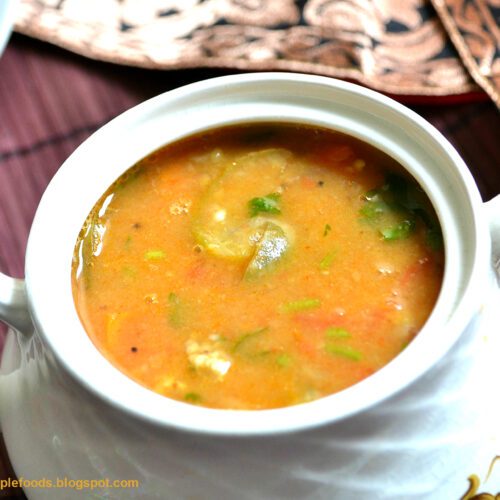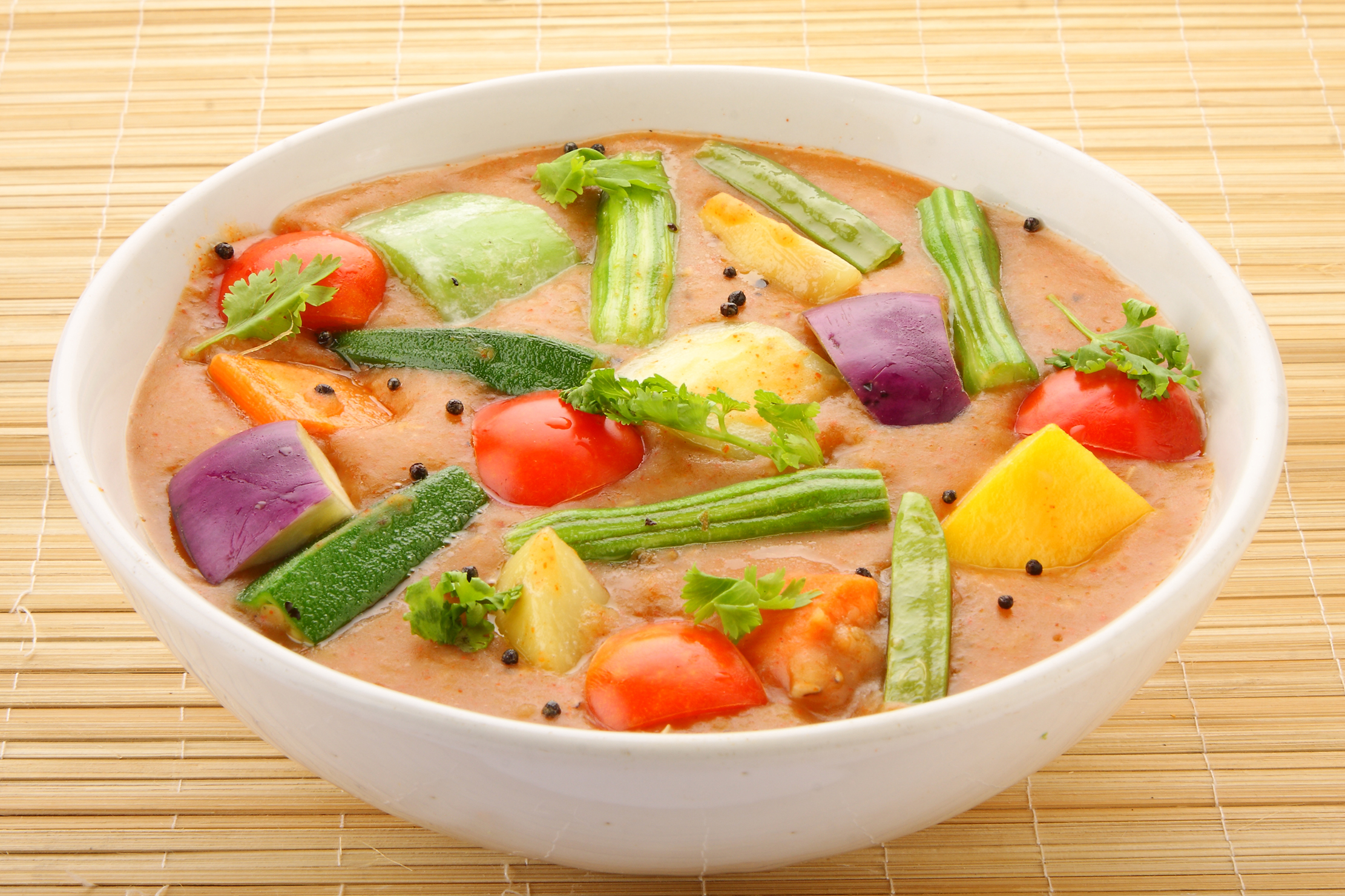Sambar is a popular South Indian dish that is enjoyed by people all over India and the world. It is a vegetable stew that is made with a unique blend of spices, lentils, and vegetables. It is a nutritious dish that is often served with rice, idli, dosa, or vada. Sambar is a flavorful and healthy dish that is perfect for any occasion.
Jump to RecipeTable of Contents
History of Sambar
The origin of sambar can be traced back to the state of Tamil Nadu in South India. The word “sambar” is believed to have been derived from the Tamil word “sambhar” which means a mixture of lentils and vegetables. Sambar was traditionally made with toor dal, tamarind, and a blend of spices.
The recipe for sambar has evolved over time, with each region in South India having its own unique variation. The addition of vegetables, spices, and herbs vary depending on the region and the season. Today, sambar is a staple dish in South Indian cuisine and is enjoyed by people all over the world.
Ingredients Used in Sambar
The ingredients used in sambar vary depending on the recipe and the region. However, there are a few key ingredients that are common in most sambar recipes:
- Toor dal – Toor dal or split pigeon peas is the primary ingredient used in sambar. It is a rich source of protein and dietary fiber.
- Tamarind – Tamarind is used to add a tangy flavor to the sambar. It is rich in antioxidants and has several health benefits.
- Vegetables – A variety of vegetables are used in sambar, including drumsticks, carrots, beans, pumpkin, brinjal, and okra. Vegetables not only add flavor but also provide essential vitamins and minerals.
- Spices – A blend of spices including coriander, cumin, fenugreek, mustard seeds, and curry leaves are used to enhance the flavor of the sambar.
- Oil – Oil or ghee is used to temper the spices and add richness to the sambar.
- Salt – Salt is added to taste.
Preparation of Sambar
The preparation of sambar involves three main steps – preparing the lentils, preparing the vegetables, and preparing the spice mix.
- Preparing the Lentils – Toor dal is cleaned, washed and soaked for about 30 minutes. It is then cooked in a pressure cooker with water, turmeric powder, and salt until it becomes soft and mushy.
- Preparing the Vegetables – The vegetables are cleaned, washed, and cut into small pieces. They are then cooked in a separate pan with water until they are soft and tender.
- Preparing the Spice Mix – A blend of spices including coriander, cumin, fenugreek, mustard seeds, and curry leaves are roasted and ground into a fine powder.
- Combining the Ingredients – The cooked dal and vegetables are then combined together in a pot. Tamarind pulp, salt, and the ground spice mix are added to the pot. The sambar is then cooked on low heat for about 10-15 minutes until it thickens.
- Tempering – For added flavor, a tempering of spices including mustard seeds, cumin seeds, curry leaves, and dried red chillies are fried in oil or ghee and added to the sambar.
Variations of Sambar
As mentioned earlier, each region in South India has its own unique variation of sambar. Some popular variations of sambar include:
- Arachuvitta Sambar: This version of sambar is made with freshly ground spices instead of sambar powder. The spices are roasted and ground with coconut and then added to the lentil and vegetable mixture. The result is a richer, more complex flavor profile.
- Mullangi Sambar: Mullangi or radish is the star of this sambar. The vegetable is added to the lentil mixture along with tamarind pulp and sambar powder. The slight bitterness of the radish adds a unique flavor to the dish.
- Keerai Sambar: This sambar is made with keerai or spinach. The spinach is cooked separately and added to the lentil and vegetable mixture. The result is a delicious and nutritious dish that is high in iron and other vitamins.
- Poricha Sambar: This is a simple and flavorful sambar made with a combination of lentils and vegetables. The lentils are cooked with a spice mix made of roasted coconut, coriander seeds, and cumin seeds. The vegetables are then added to the lentil mixture and cooked until tender.
- Kalyana Sambar: Kalyana sambar is a special version of sambar that is served at weddings and other special occasions. This sambar is made with a variety of vegetables, including drumstick, brinjal, pumpkin, and carrot. The spices used in this sambar are slightly different from the regular sambar powder, giving it a unique flavor.
- Milagu Sambar: Milagu or pepper is the star of this sambar. The lentils and vegetables are cooked with a spice mix made of roasted pepper, cumin seeds, and coriander seeds. The result is a spicy and flavorful sambar that is perfect for cold, rainy days.
- Udupi Sambar: This sambar is a specialty of the Udupi region of Karnataka. It is made with a unique blend of spices, including fenugreek, asafoetida, and curry leaves. The vegetables used in this sambar are typically pumpkin, drumstick, and brinjal.
- Pasi Paruppu Sambar: Pasi paruppu or moong dal is used to make this sambar. The lentils are cooked with tamarind pulp and sambar powder. Vegetables like pumpkin, drumstick, and brinjal are then added to the mixture. The result is a light and flavorful sambar that is perfect for a hot summer day.
- Thakkali Sambar: Thakkali or tomato is the star of this sambar. The lentils and vegetables are cooked with a spice mix made of roasted coriander seeds, cumin seeds, and red chili. The tomatoes are added to the mixture and cooked until tender. The result is a tangy and flavorful sambar that is perfect with rice or idli.
- Vengaya Sambar: Vengaya or onion is the star of this sambar. The onions are cooked until caramelized and then added to the lentil mixture along with tamarind pulp and sambar powder. The result is a sweet and savory sambar that is perfect with dosa or vada.
Recipe Card >>

Sambar Recipe: A Quick and Flavorful South Indian Delight
Ingredients
- 1 cup toor dal
- 1 onion chopped
- 1 tomato chopped
- 1 carrot chopped
- 1 potato chopped
- 1 drumstick chopped
- 1 brinjal chopped
- 10-12 curry leaves
- 2 tbsp sambar powder
- 1 tsp turmeric powder
- 1 tsp mustard seeds
- 1 tsp cumin seeds
- 1 tsp fenugreek seeds
- 2 dried red chillies
- 2 tbsp oil
- Salt to taste
- Tamarind lemon-sized
Instructions
- Wash the toor dal and soak it in water for 20 minutes.
- In a pressure cooker, cook the toor dal with 3 cups of water, turmeric powder and a few drops of oil until it’s completely soft and mushy. Set aside.
- Soak the tamarind in warm water for 10 minutes. Squeeze the tamarind to extract the juice and set aside.
- Heat oil in a pan and add mustard seeds, cumin seeds and fenugreek seeds.
- Once they start spluttering, add the chopped onions and curry leaves.
- Saute until the onions turn golden brown.
- Add chopped tomatoes and cook until they turn soft and mushy.
- Add the chopped vegetables and saute for a few minutes.
- Add sambar powder and mix well.
- Pour in 4-5 cups of water and bring it to a boil.
- Add the tamarind juice and salt to taste.
- Cover the pan and let it simmer for 15-20 minutes or until the vegetables are cooked.
- Add the cooked dal to the pan and mix well.
- Let it simmer for another 5-10 minutes or until the dal is well combined with the sambar.
- Garnish with chopped coriander leaves.
Notes
- Vegetables: You can use any combination of vegetables you prefer for sambar. Some popular choices include eggplant, okra, drumstick, pumpkin, carrots, and potatoes.
- Tamarind: Tamarind is an essential ingredient for sambar as it adds a tangy flavor to the dish. You can use tamarind paste or soak a small ball of tamarind in warm water and extract the pulp.
- Sambar powder: Sambar powder is a blend of various spices that give sambar its distinct flavor. You can use store-bought sambar powder or make your own by grinding coriander seeds, cumin seeds, dried red chilies, fenugreek seeds, mustard seeds, and turmeric powder.
- Lentils: The type of lentils used in sambar is usually toor dal (yellow split pigeon peas) or masoor dal (red lentils). Soak the lentils in water for at least 30 minutes before cooking.
- Tempering: The tempering or tadka is a crucial step in the sambar recipe. It involves heating oil or ghee in a pan and adding mustard seeds, cumin seeds, curry leaves, dried red chilies, and asafoetida. The tempering is added to the sambar just before serving.
Checkout our Most delicious Desserts Recipe of Besan Halwa , Besan Burfi, Almond Badam Katli
Feel Free to provide Feedback in our Contact Us Section
